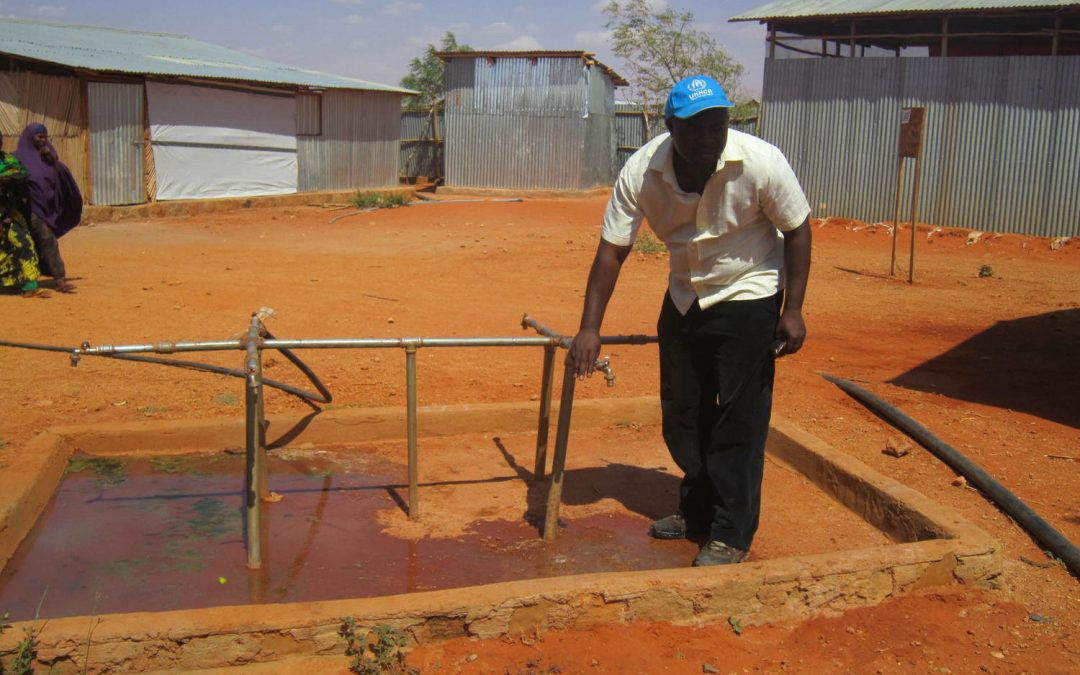Creating sustainable water and sanitation solutions in Kobe refugee camp.
As an engineer working in the five refugee camps located in Dollo Ado, Ethiopia, UNHCR Innovation Fellow, Samuel Gonzaga was facing a growing challenge – the water and sanitation systems originally set up in the camp were highly dependent on external resources, and were eating up a substantial part of UNHCR’s dwindling operating budget for the area. In the Kobe camp, the agency was spending hundreds of thousands of dollars each year on running a fuel-based water treatment system. In the Hiloweyn camp, old latrines needed to be replaced, but digging up new holes in the rocky soil would require expensive machinery. The camps were clearly in need of more sustainable solutions.
Kobe relied on water truck delivery until a permanent system was set up, pumping water from a nearby river to a reservoir up the hill. However the new system relied on generators, and was using a substantial amount of fuel, which was neither cost-effective nor eco-friendly. Another challenge was to make the system transferrable to host populations, in the event that refugees would leave. In partnership with Veolia Environment, Gonzaga and his team came up with the idea of a hybrid system combining solar power and diesel generators. Working without batteries, the solar components are easy to maintain and could eventually be used alone by the host community, albeit intermittently.
“When the refugees leave, the host community will be able to operate the solar system,” Gonzaga says. “It won’t end up becoming a white elephant.”
In Hiloweyn, pit latrines were originally dug with heavy-duty machinery, temporarily brought to Dollo Ado at the peak of the humanitarian emergency. A couple of years later, the old latrines were filling up, and new ones needed to be dug – a process that would have needed to be replicated again and again. A more sensible solution was to switch to a sustainable approach based on the 3 Rs: Reduce, Reuse and Recycle. Gonzaga and his team opted for the Urine Diversion Dry Toilet (UDDT), which requires no excavation. Instead, the UDDT diverts the urine from the faeces without any flush water. Dried excreta are then left to dry for a few months, during which pathogens progressively die off, before being reused as fertilizer. The project started off with 40 UDDTs a pilot funded by OXFAM, then expanded to over 2000 UDDTs in Hiloweyn, and is now being successfully implemented in other camps. UNHCR has also partnered with the U.S. Center for Disease Control (CDC) to run tests and determine when the latrines’ content will be safe to remove for reuse.
Both projects ran into challenges. The hybrid water system took longer to design than anticipated, and was further delayed by a tedious negotiation process with suppliers. The UDDT project also experienced a temporary setback when it was revealed the urine diversion pipe was being clogged with rocks, and had to be replaced by a larger one. But Gonzaga learned these challenges were also part of the process.
“One thing we’re not worried about is failing,” he explains. “Even what is considered negative can turn out to be positive if you keep on improving the product.”
Overall, both projects have taught him a lot about innovation, notably the need to go through various steps – defining the problem, identifying solutions, creating a prototype, and scaling it up.
“For me, the process was very important – more important than the technology,” he says.
He’s also learned about the importance of acceptance of the project by end users. He knew the UDDT would be embraced by refugees, for instance, because it answered the need they had voiced to eliminate the smell of latrines (the UDDT is odourless) and successfully went through the piloting phase. But when the toilets experienced clogging issues, the local population began doubting the efficiency of the system, and the team needed to fix the problem quickly in order to regain their trust.
Gonzaga is not a renewable energy expert himself, but he learned how to partner with different types of people in order to draw from their expertise. While the collaboration with Veolia Environment was rather straightforward, the UDDT project received the input from a number of experts in renewable energy, sanitation and water, and the team partnered with a local university who had prototyped a similar system. “You really need to network with different skill sets,” he points out.
The hybrid water system is now about to be installed in Kobe, and the UDDT continues to be scaled up. Both will likely require further fine-tuning before being fully handed to the refugee community – a key question for the UDDT will be whether refugees will adopt the “dry cake” as a fertilizer. But Gonzaga is confident these projects will eventually make the case for investing in sustainable water and sanitation solutions in the camps – and for playing the innovation game.
“There always challenges along the way. The only thing that matters is that you keep on improving your ideas,” he says.

